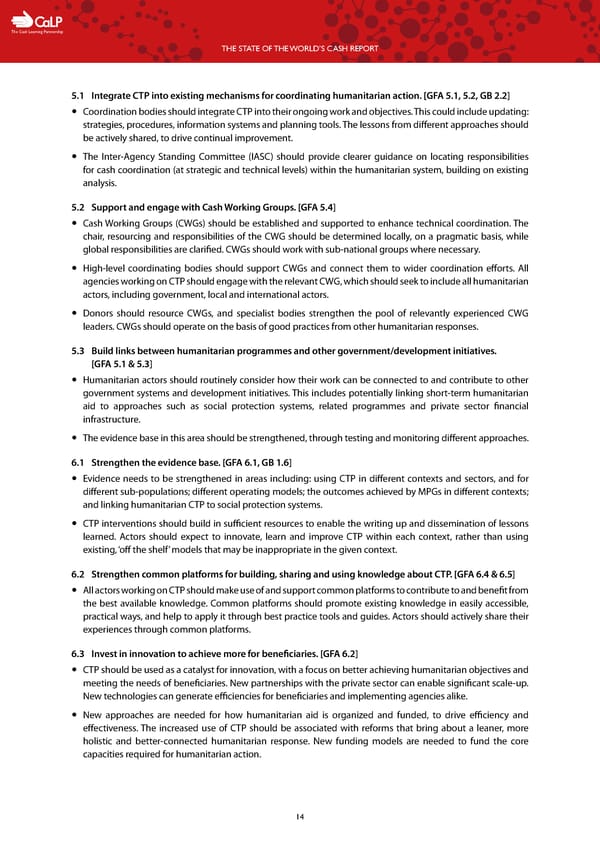C The Cash Learning Partnership THE STATE OF THE WORLD’S CASH REPORT 5.1 I ntegrate CTP into existing mechanisms for coordinating humanitarian action. [GFA 5.1, 5.2, GB 2.2] — Coordination bodies should integrate CTP into their ongoing work and objectives. This could include updating: strategies, procedures, information systems and planning tools. The lessons from different approaches should be actively shared, to drive continual improvement. — The Inter-Agency Standing Committee (IASC) should provide clearer guidance on locating responsibilities for cash coordination (at strategic and technical levels) within the humanitarian system, building on existing analysis. 5.2 Support and engage with Cash Working Groups. [GFA 5.4] — Cash Working Groups (CWGs) should be established and supported to enhance technical coordination. The chair, resourcing and responsibilities of the CWG should be determined locally, on a pragmatic basis, while global responsibilities are clarified. CWGs should work with sub-national groups where necessary. — High-level coordinating bodies should support CWGs and connect them to wider coordination efforts. All agencies working on CTP should engage with the relevant CWG, which should seek to include all humanitarian actors, including government, local and international actors. — Donors should resource CWGs, and specialist bodies strengthen the pool of relevantly experienced CWG leaders. CWGs should operate on the basis of good practices from other humanitarian responses. 5.3 Build links bet ween humanitarian programmes and other government/development initiatives. [GFA 5.1 & 5.3] — Humanitarian actors should routinely consider how their work can be connected to and contribute to other government systems and development initiatives. This includes potentially linking short-term humanitarian aid to approaches such as social protection systems, related programmes and private sector financial infrastructure. — The evidence base in this area should be strengthened, through testing and monitoring different approaches. 6.1 Strengthen the evidence base. [GFA 6.1, GB 1.6] — Evidence needs to be strengthened in areas including: using CTP in different contexts and sectors, and for different sub-populations; different operating models; the outcomes achieved by MPGs in different contexts; and linking humanitarian CTP to social protection systems. — CTP interventions should build in sufficient resources to enable the writing up and dissemination of lessons learned. Actors should expect to innovate, learn and improve CTP within each context, rather than using existing, ‘off the shelf’ models that may be inappropriate in the given context. 6.2 S trengthen common platforms for building, sharing and using knowledge about CTP. [GFA 6.4 & 6.5] — All actors working on CTP should make use of and support common platforms to contribute to and benefit from the best available knowledge. Common platforms should promote existing knowledge in easily accessible, practical ways, and help to apply it through best practice tools and guides. Actors should actively share their experiences through common platforms. 6.3 Invest in innovation to achieve more for beneficiaries. [GFA 6.2] — CTP should be used as a catalyst for innovation, with a focus on better achieving humanitarian objectives and meeting the needs of beneficiaries. New partnerships with the private sector can enable significant scale-up. New technologies can generate efficiencies for beneficiaries and implementing agencies alike. — New approaches are needed for how humanitarian aid is organized and funded, to drive efficiency and effectiveness. The increased use of CTP should be associated with reforms that bring about a leaner, more holistic and better-connected humanitarian response. New funding models are needed to fund the core capacities required for humanitarian action. 14
 The State of the World's Cash | Full Report Page 15 Page 17
The State of the World's Cash | Full Report Page 15 Page 17